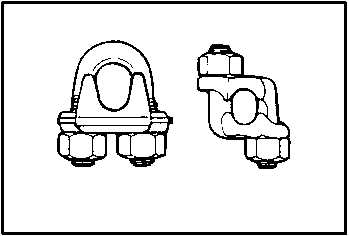TM5-3810-305-10
To avoid many dangerous prac-
tices, play it safe by following
correct procedures. Failure to
follow these procedures could
cause loads to fall causing
DEATH or serious injury.
When preparing a wire rope for socketing, it is of
extreme importance to follow recommended
procedures (refer to page 4-40). Procedures
other than those stipulated here may develop the
required strength but this cannot be predeter-
mined without destructive tests. It is far safer
and ultimately less costly to follow well-estab-
lished practices.
There are many ways to go wrong in socketing
procedures. Some of the more common PIT-
FALLS THAT SHOULD BE GUARDED
AGAINST include:
1.
2.
3.
4.
5.
Turning back the strands, inward or outward,
before the “broom” is inserted into the socket.
Turning back the strands and seizing them to
the body of the rope.
Turning back the strands and tucking them
into the body of the rope.
Tying a knot in the rope.
Driving nails, spikes, bolts and similar objects
into the socket after the rope is in, so as to
“jam” it tight; this is particularly dangerous
and ruinous.
Wire Rope Clips
Wire rope clips are widely used for attaching
wire rope to haulages, mine cars and hoists, and
for joining two ropes,
Clips are available in two basic designs: the U-
bolt and fist grip (Figure 4-34). The efficiency
of both types is the same.
U-BOLT
FIST GRIP
Figure 4-34. Basic Designs of Wire Rope Clips
4-37

